light PONTIAC GRAND PRIX 2006 Service Manual
[x] Cancel search | Manufacturer: PONTIAC, Model Year: 2006, Model line: GRAND PRIX, Model: PONTIAC GRAND PRIX 2006Pages: 472, PDF Size: 2.82 MB
Page 147 of 472
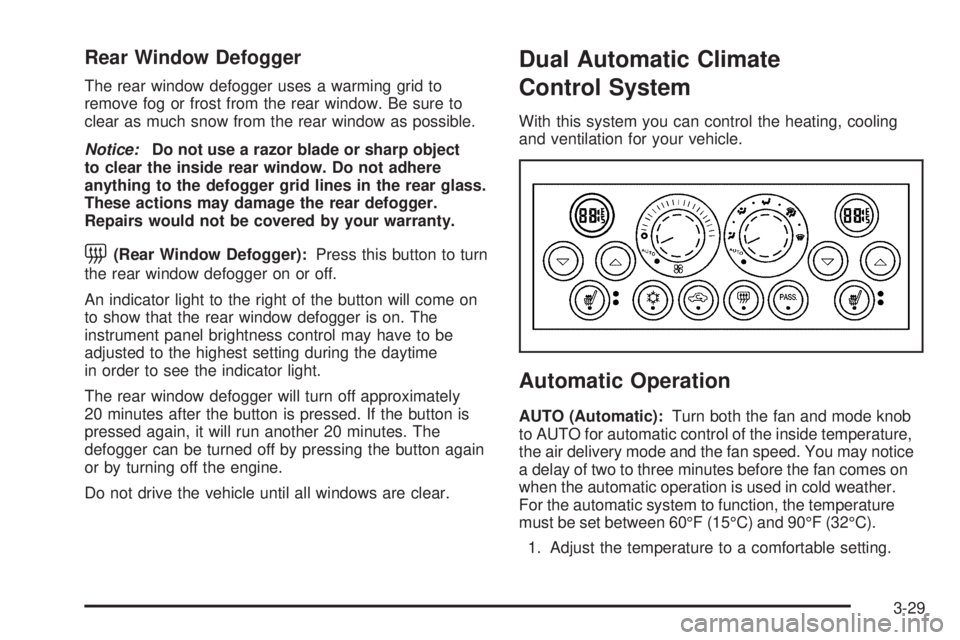
Rear Window Defogger
The rear window defogger uses a warming grid to
remove fog or frost from the rear window. Be sure to
clear as much snow from the rear window as possible.
Notice:Do not use a razor blade or sharp object
to clear the inside rear window. Do not adhere
anything to the defogger grid lines in the rear glass.
These actions may damage the rear defogger.
Repairs would not be covered by your warranty.
=(Rear Window Defogger):Press this button to turn
the rear window defogger on or off.
An indicator light to the right of the button will come on
to show that the rear window defogger is on. The
instrument panel brightness control may have to be
adjusted to the highest setting during the daytime
in order to see the indicator light.
The rear window defogger will turn off approximately
20 minutes after the button is pressed. If the button is
pressed again, it will run another 20 minutes. The
defogger can be turned off by pressing the button again
or by turning off the engine.
Do not drive the vehicle until all windows are clear.
Dual Automatic Climate
Control System
With this system you can control the heating, cooling
and ventilation for your vehicle.
Automatic Operation
AUTO (Automatic):Turn both the fan and mode knob
to AUTO for automatic control of the inside temperature,
the air delivery mode and the fan speed. You may notice
a delay of two to three minutes before the fan comes on
when the automatic operation is used in cold weather.
For the automatic system to function, the temperature
must be set between 60°F (15°C) and 90°F (32°C).
1. Adjust the temperature to a comfortable setting.
3-29
Page 149 of 472
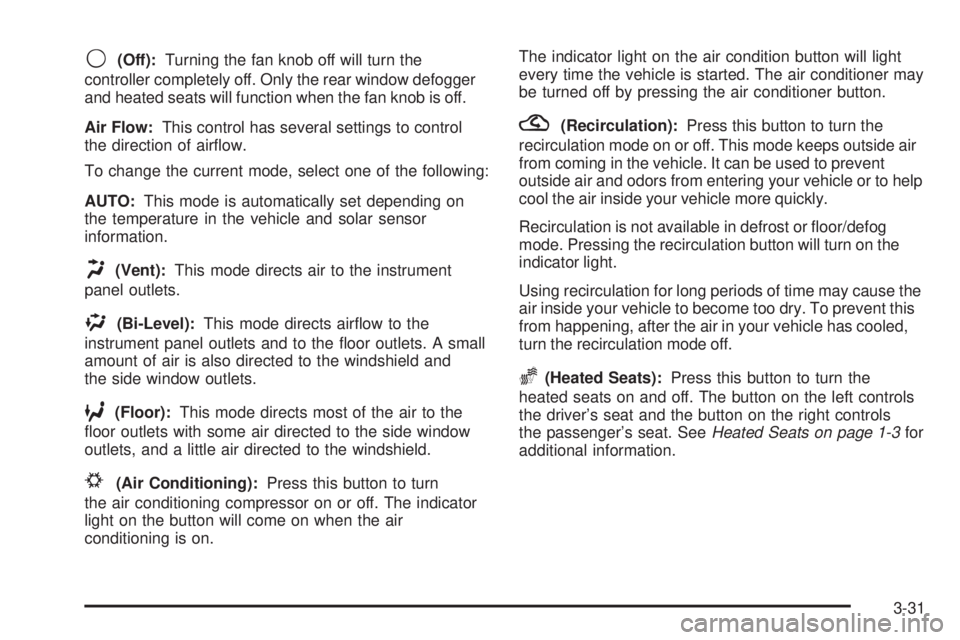
9(Off):Turning the fan knob off will turn the
controller completely off. Only the rear window defogger
and heated seats will function when the fan knob is off.
Air Flow:This control has several settings to control
the direction of air�ow.
To change the current mode, select one of the following:
AUTO:This mode is automatically set depending on
the temperature in the vehicle and solar sensor
information.
H(Vent):This mode directs air to the instrument
panel outlets.
%(Bi-Level):This mode directs air�ow to the
instrument panel outlets and to the �oor outlets. A small
amount of air is also directed to the windshield and
the side window outlets.
6(Floor):This mode directs most of the air to the
�oor outlets with some air directed to the side window
outlets, and a little air directed to the windshield.
#(Air Conditioning):Press this button to turn
the air conditioning compressor on or off. The indicator
light on the button will come on when the air
conditioning is on.The indicator light on the air condition button will light
every time the vehicle is started. The air conditioner may
be turned off by pressing the air conditioner button.
?(Recirculation):Press this button to turn the
recirculation mode on or off. This mode keeps outside air
from coming in the vehicle. It can be used to prevent
outside air and odors from entering your vehicle or to help
cool the air inside your vehicle more quickly.
Recirculation is not available in defrost or �oor/defog
mode. Pressing the recirculation button will turn on the
indicator light.
Using recirculation for long periods of time may cause the
air inside your vehicle to become too dry. To prevent this
from happening, after the air in your vehicle has cooled,
turn the recirculation mode off.
z(Heated Seats):Press this button to turn the
heated seats on and off. The button on the left controls
the driver’s seat and the button on the right controls
the passenger’s seat. SeeHeated Seats on page 1-3for
additional information.
3-31
Page 150 of 472
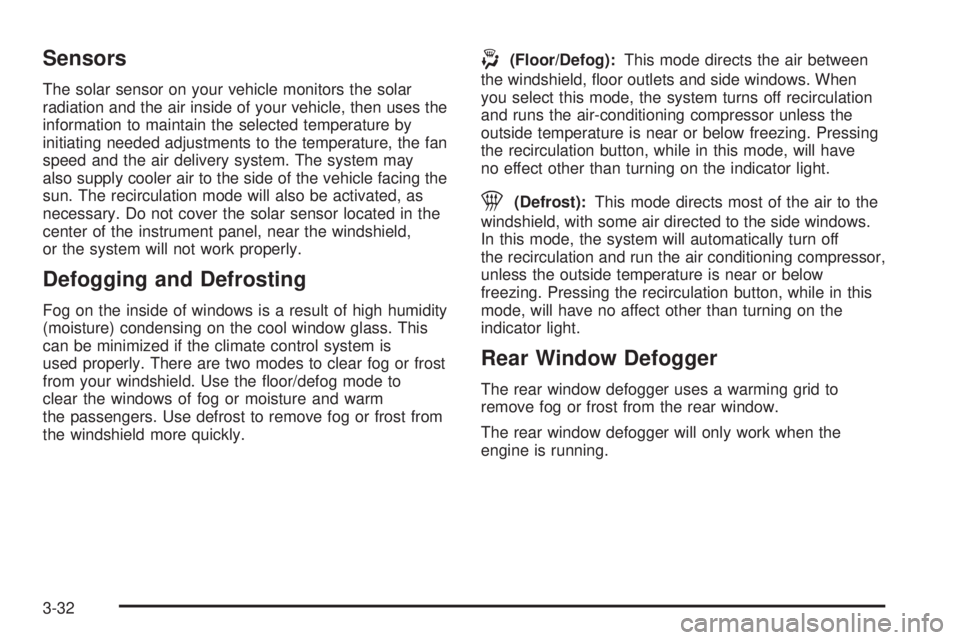
Sensors
The solar sensor on your vehicle monitors the solar
radiation and the air inside of your vehicle, then uses the
information to maintain the selected temperature by
initiating needed adjustments to the temperature, the fan
speed and the air delivery system. The system may
also supply cooler air to the side of the vehicle facing the
sun. The recirculation mode will also be activated, as
necessary. Do not cover the solar sensor located in the
center of the instrument panel, near the windshield,
or the system will not work properly.
Defogging and Defrosting
Fog on the inside of windows is a result of high humidity
(moisture) condensing on the cool window glass. This
can be minimized if the climate control system is
used properly. There are two modes to clear fog or frost
from your windshield. Use the �oor/defog mode to
clear the windows of fog or moisture and warm
the passengers. Use defrost to remove fog or frost from
the windshield more quickly.
-(Floor/Defog):This mode directs the air between
the windshield, �oor outlets and side windows. When
you select this mode, the system turns off recirculation
and runs the air-conditioning compressor unless the
outside temperature is near or below freezing. Pressing
the recirculation button, while in this mode, will have
no effect other than turning on the indicator light.
1(Defrost):This mode directs most of the air to the
windshield, with some air directed to the side windows.
In this mode, the system will automatically turn off
the recirculation and run the air conditioning compressor,
unless the outside temperature is near or below
freezing. Pressing the recirculation button, while in this
mode, will have no affect other than turning on the
indicator light.
Rear Window Defogger
The rear window defogger uses a warming grid to
remove fog or frost from the rear window.
The rear window defogger will only work when the
engine is running.
3-32
Page 153 of 472
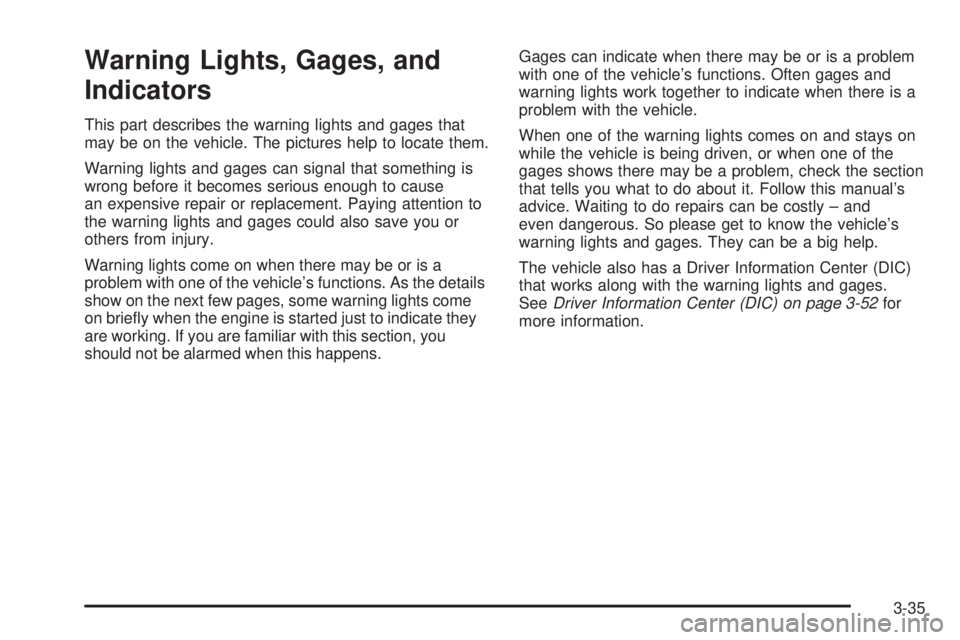
Warning Lights, Gages, and
Indicators
This part describes the warning lights and gages that
may be on the vehicle. The pictures help to locate them.
Warning lights and gages can signal that something is
wrong before it becomes serious enough to cause
an expensive repair or replacement. Paying attention to
the warning lights and gages could also save you or
others from injury.
Warning lights come on when there may be or is a
problem with one of the vehicle’s functions. As the details
show on the next few pages, some warning lights come
on brie�y when the engine is started just to indicate they
are working. If you are familiar with this section, you
should not be alarmed when this happens.Gages can indicate when there may be or is a problem
with one of the vehicle’s functions. Often gages and
warning lights work together to indicate when there is a
problem with the vehicle.
When one of the warning lights comes on and stays on
while the vehicle is being driven, or when one of the
gages shows there may be a problem, check the section
that tells you what to do about it. Follow this manual’s
advice. Waiting to do repairs can be costly – and
even dangerous. So please get to know the vehicle’s
warning lights and gages. They can be a big help.
The vehicle also has a Driver Information Center (DIC)
that works along with the warning lights and gages.
SeeDriver Information Center (DIC) on page 3-52for
more information.
3-35
Page 155 of 472
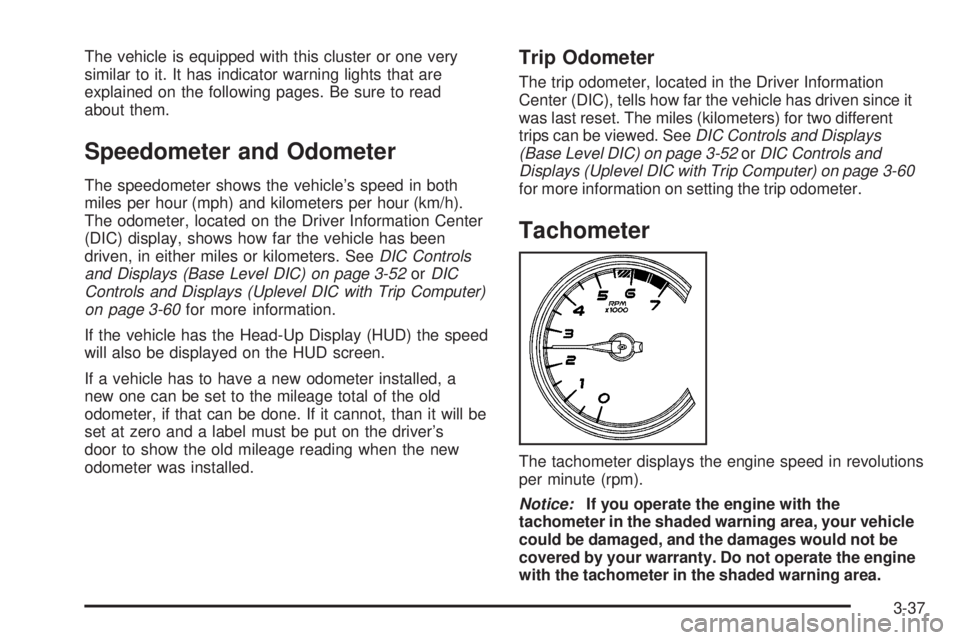
The vehicle is equipped with this cluster or one very
similar to it. It has indicator warning lights that are
explained on the following pages. Be sure to read
about them.
Speedometer and Odometer
The speedometer shows the vehicle’s speed in both
miles per hour (mph) and kilometers per hour (km/h).
The odometer, located on the Driver Information Center
(DIC) display, shows how far the vehicle has been
driven, in either miles or kilometers. SeeDIC Controls
and Displays (Base Level DIC) on page 3-52orDIC
Controls and Displays (Uplevel DIC with Trip Computer)
on page 3-60for more information.
If the vehicle has the Head-Up Display (HUD) the speed
will also be displayed on the HUD screen.
If a vehicle has to have a new odometer installed, a
new one can be set to the mileage total of the old
odometer, if that can be done. If it cannot, than it will be
set at zero and a label must be put on the driver’s
door to show the old mileage reading when the new
odometer was installed.
Trip Odometer
The trip odometer, located in the Driver Information
Center (DIC), tells how far the vehicle has driven since it
was last reset. The miles (kilometers) for two different
trips can be viewed. SeeDIC Controls and Displays
(Base Level DIC) on page 3-52orDIC Controls and
Displays (Uplevel DIC with Trip Computer) on page 3-60
for more information on setting the trip odometer.
Tachometer
The tachometer displays the engine speed in revolutions
per minute (rpm).
Notice:If you operate the engine with the
tachometer in the shaded warning area, your vehicle
could be damaged, and the damages would not be
covered by your warranty. Do not operate the engine
with the tachometer in the shaded warning area.
3-37
Page 156 of 472
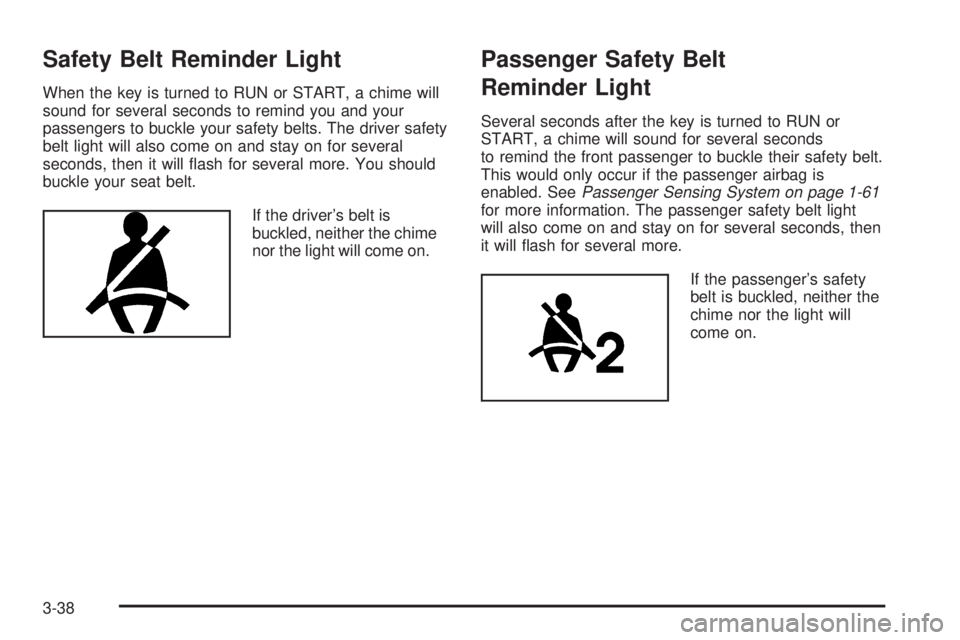
Safety Belt Reminder Light
When the key is turned to RUN or START, a chime will
sound for several seconds to remind you and your
passengers to buckle your safety belts. The driver safety
belt light will also come on and stay on for several
seconds, then it will �ash for several more. You should
buckle your seat belt.
If the driver’s belt is
buckled, neither the chime
nor the light will come on.
Passenger Safety Belt
Reminder Light
Several seconds after the key is turned to RUN or
START, a chime will sound for several seconds
to remind the front passenger to buckle their safety belt.
This would only occur if the passenger airbag is
enabled. SeePassenger Sensing System on page 1-61
for more information. The passenger safety belt light
will also come on and stay on for several seconds, then
it will �ash for several more.
If the passenger’s safety
belt is buckled, neither the
chime nor the light will
come on.
3-38
Page 157 of 472
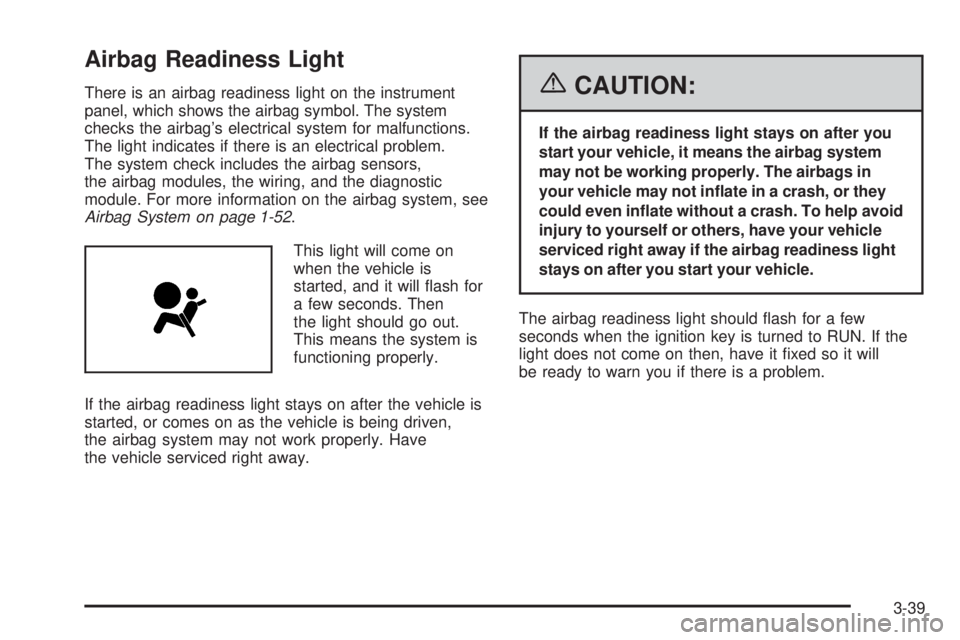
Airbag Readiness Light
There is an airbag readiness light on the instrument
panel, which shows the airbag symbol. The system
checks the airbag’s electrical system for malfunctions.
The light indicates if there is an electrical problem.
The system check includes the airbag sensors,
the airbag modules, the wiring, and the diagnostic
module. For more information on the airbag system, see
Airbag System on page 1-52.
This light will come on
when the vehicle is
started, and it will �ash for
a few seconds. Then
the light should go out.
This means the system is
functioning properly.
If the airbag readiness light stays on after the vehicle is
started, or comes on as the vehicle is being driven,
the airbag system may not work properly. Have
the vehicle serviced right away.{CAUTION:
If the airbag readiness light stays on after you
start your vehicle, it means the airbag system
may not be working properly. The airbags in
your vehicle may not in�ate in a crash, or they
could even in�ate without a crash. To help avoid
injury to yourself or others, have your vehicle
serviced right away if the airbag readiness light
stays on after you start your vehicle.
The airbag readiness light should �ash for a few
seconds when the ignition key is turned to RUN. If the
light does not come on then, have it �xed so it will
be ready to warn you if there is a problem.
3-39
Page 158 of 472
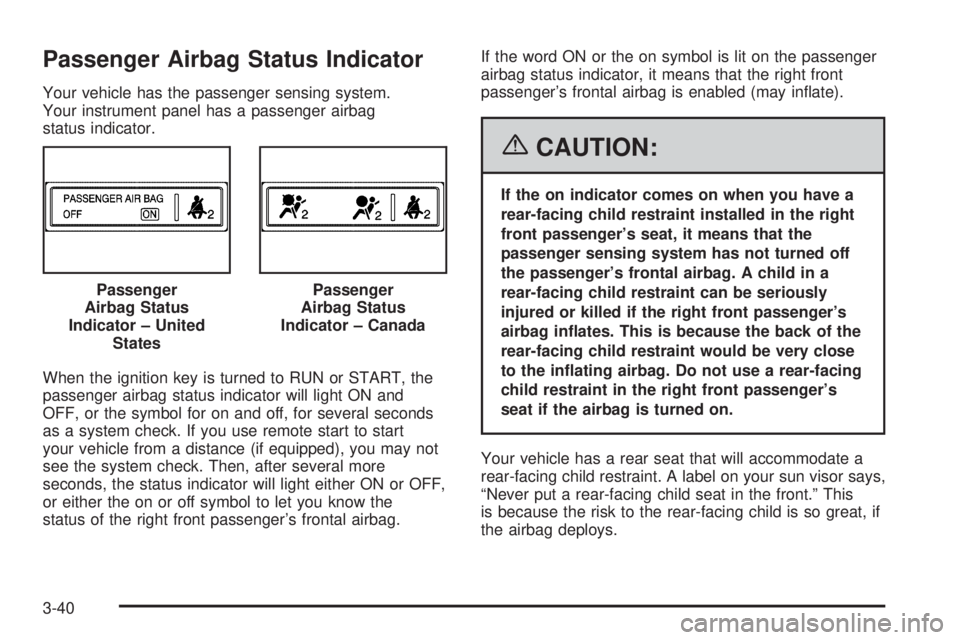
Passenger Airbag Status Indicator
Your vehicle has the passenger sensing system.
Your instrument panel has a passenger airbag
status indicator.
When the ignition key is turned to RUN or START, the
passenger airbag status indicator will light ON and
OFF, or the symbol for on and off, for several seconds
as a system check. If you use remote start to start
your vehicle from a distance (if equipped), you may not
see the system check. Then, after several more
seconds, the status indicator will light either ON or OFF,
or either the on or off symbol to let you know the
status of the right front passenger’s frontal airbag.If the word ON or the on symbol is lit on the passenger
airbag status indicator, it means that the right front
passenger’s frontal airbag is enabled (may in�ate).
{CAUTION:
If the on indicator comes on when you have a
rear-facing child restraint installed in the right
front passenger’s seat, it means that the
passenger sensing system has not turned off
the passenger’s frontal airbag. A child in a
rear-facing child restraint can be seriously
injured or killed if the right front passenger’s
airbag in�ates. This is because the back of the
rear-facing child restraint would be very close
to the in�ating airbag. Do not use a rear-facing
child restraint in the right front passenger’s
seat if the airbag is turned on.
Your vehicle has a rear seat that will accommodate a
rear-facing child restraint. A label on your sun visor says,
“Never put a rear-facing child seat in the front.” This
is because the risk to the rear-facing child is so great, if
the airbag deploys. Passenger
Airbag Status
Indicator – United
States
Passenger
Airbag Status
Indicator – Canada
3-40
Page 159 of 472
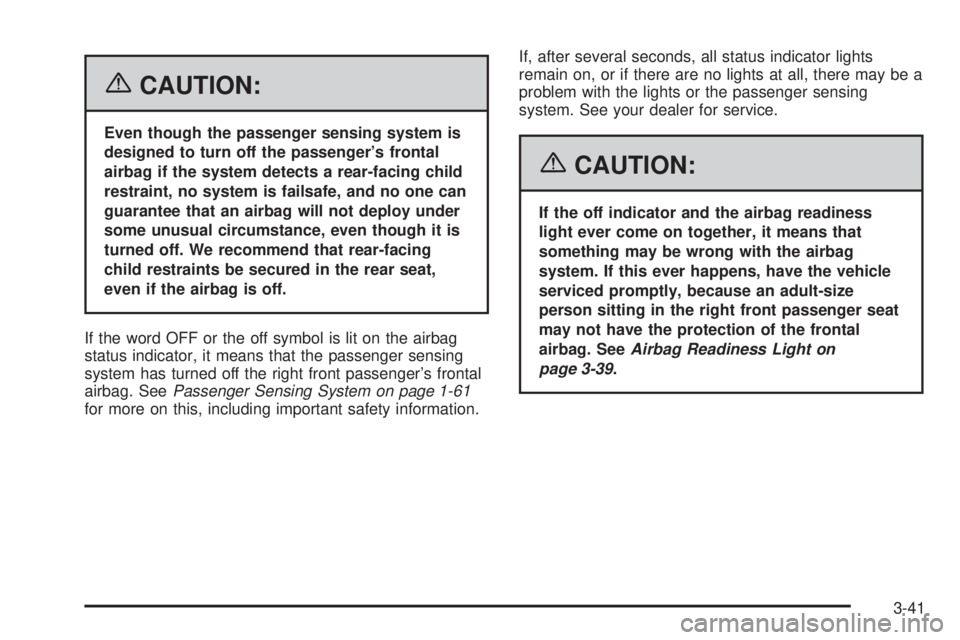
{CAUTION:
Even though the passenger sensing system is
designed to turn off the passenger’s frontal
airbag if the system detects a rear-facing child
restraint, no system is failsafe, and no one can
guarantee that an airbag will not deploy under
some unusual circumstance, even though it is
turned off. We recommend that rear-facing
child restraints be secured in the rear seat,
even if the airbag is off.
If the word OFF or the off symbol is lit on the airbag
status indicator, it means that the passenger sensing
system has turned off the right front passenger’s frontal
airbag. SeePassenger Sensing System on page 1-61
for more on this, including important safety information.If, after several seconds, all status indicator lights
remain on, or if there are no lights at all, there may be a
problem with the lights or the passenger sensing
system. See your dealer for service.
{CAUTION:
If the off indicator and the airbag readiness
light ever come on together, it means that
something may be wrong with the airbag
system. If this ever happens, have the vehicle
serviced promptly, because an adult-size
person sitting in the right front passenger seat
may not have the protection of the frontal
airbag. SeeAirbag Readiness Light on
page 3-39.
3-41
Page 160 of 472
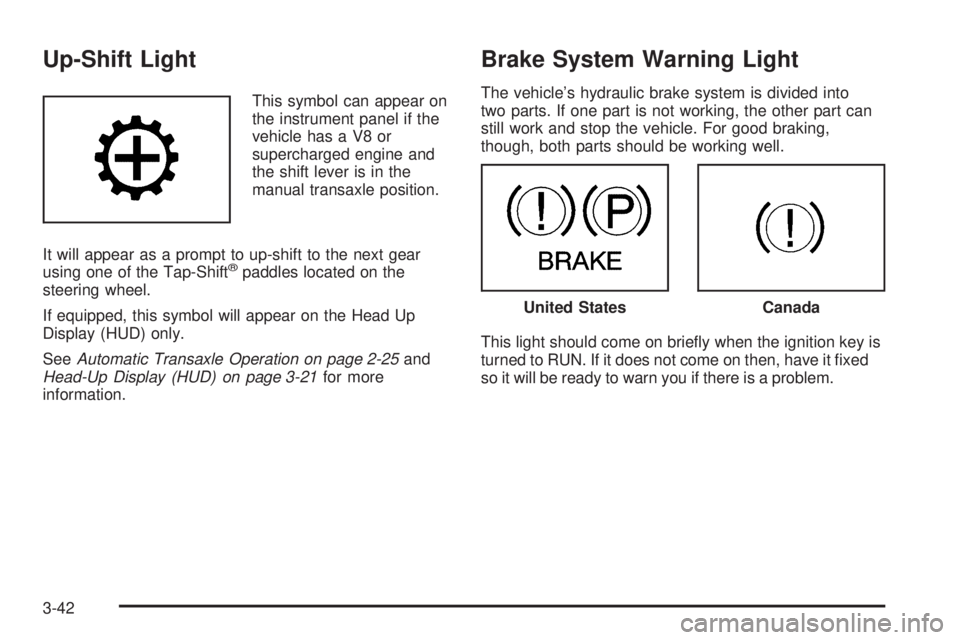
Up-Shift Light
This symbol can appear on
the instrument panel if the
vehicle has a V8 or
supercharged engine and
the shift lever is in the
manual transaxle position.
It will appear as a prompt to up-shift to the next gear
using one of the Tap-Shift
®paddles located on the
steering wheel.
If equipped, this symbol will appear on the Head Up
Display (HUD) only.
SeeAutomatic Transaxle Operation on page 2-25and
Head-Up Display (HUD) on page 3-21for more
information.
Brake System Warning Light
The vehicle’s hydraulic brake system is divided into
two parts. If one part is not working, the other part can
still work and stop the vehicle. For good braking,
though, both parts should be working well.
This light should come on brie�y when the ignition key is
turned to RUN. If it does not come on then, have it �xed
so it will be ready to warn you if there is a problem.
United StatesCanada
3-42